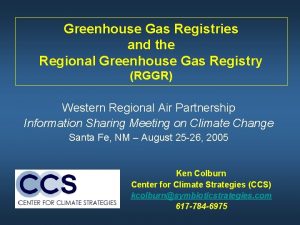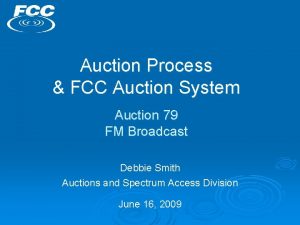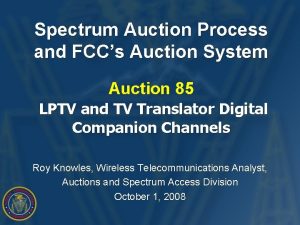Regional Greenhouse Gas Initiative First auction results the











- Slides: 11

Regional Greenhouse Gas Initiative: First auction results & the future New England Restructuring Roundtable DEP Commissioner Laurie Burt December 5, 2008 1

Patchwork Approach? No, Beautiful Quilt. 2

RGGI Basics • First mandatory cap-and-trade program for CO 2 • 10 States: MA, RI, NJ, NH, VT, ME, NY, CT, MD, DE • Program covers power generators > 25 MW • Current cap = 188 million tons • 10% reduction in 2009 CO 2 levels by 2019 • Auction nearly 100% of allowances • First compliance period begins Jan 1, 2009 3

RGGI Initial Goals • Stabilize GHG emissions • Create a market for carbon • Demonstrate a state-led regional program can work • Professional, predictable auction model • Aggressive investment in energy efficiency and renewables 4

First Auction: RGGI on the Move • September 25, 2008 • 12. 5 million allowances auctioned • 59 separate entities submitted bids, 44 entities purchased allowances (80 percent sold to compliance entities) • Demand outpaced supply 4: 1 Ø $1. 86 Reserve Price Ø $3. 07 Clearing Price Ø $38. 5 million total proceeds ($13. 5 million to MA) Market Monitor, Potomac Economics: “Auction raised no material concerns…” 5

Second Auction: December 17, 2008 Any Changes? • All 10 RGGI states plan to participate • 31. 5 million allowances • Clearing price and # of allowances sold released w/in 48 hours of auction close. • Post-settlement report (dispersion of bids, type of bidder) released Jan 6 Auction schedule at: http: //rggi. org/docs/Auction_Schedule_Oct_13_2008. pdf 6

Where Will the Money Go? Energy Efficiency & Renewable Energy: Massachusetts, Maryland, New Hampshire, New Jersey, New York Consumer-Focused Programs (to reduce longterm energy demand costs): Connecticut, Delaware, Maine, Rhode Island, Vermont 7

RGGI funds in Massachusetts are already being deployed 80 percent to energy efficiency: • $6 M: Fund 100 percent of electric utility companies proposed winter 2008 efficiency program increases ($3 M from each auction) • $3 M: Help cities and towns implement energy efficiency • $4 M: Help low-income households be more energy efficient through state’s HEARTWAP ($2 M from each auction) • $5 M: Kick-start Green Communities Act 8

What’s Next for RGGI? • Offsets • Future areas of collaboration: • Low carbon fuel standard (LCFS) • CA LEV program (8/10 RGGI states have adopted) • GHG reporting − 10 states require GHG reporting: CA, CT, MA, ME, NV, NJ, NM, OR, WA − MA Global Warming Solutions Act requires GHG reporting >5, 000 tons/year in CO 2 e, including commercial/industrial • Anticipated RGGI would expand to other sectors 9

What’s Next for RGGI? • RGGI’s relationship to WCI and Midwest Greenhouse Gas Accord • What about Florida? 10

Federal Program • RGGI designed as glide path for federal action • RGGI has brought energy/environmental agencies together in unprecedented ways. • We will insist: − − 11 Strong state-federal partnership Credit to states who have implemented GHG policy Support at least at the RGGI level State role: monitoring, reporting, permitting, energy efficiency, siting & building renewables

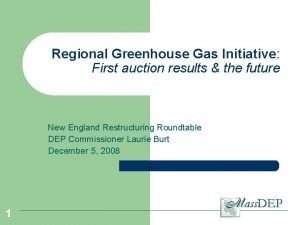
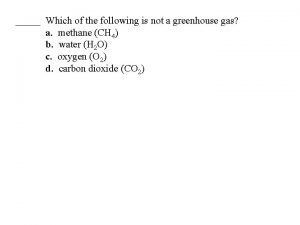
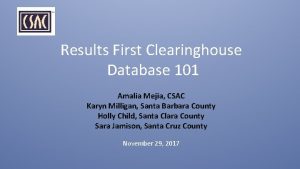

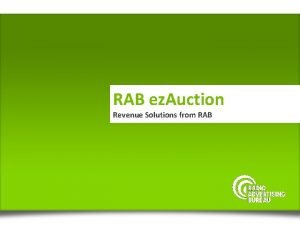
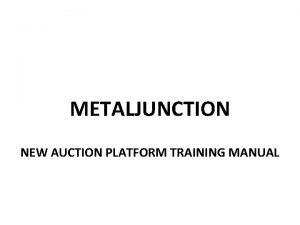

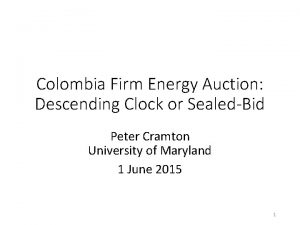


![Ice] inkan auction Ice] inkan auction](https://slidetodoc.com/wp-content/uploads/2021/03/4265618_1c2d54474a1aa46eca42079887e1f0d3-300x225.jpg)
